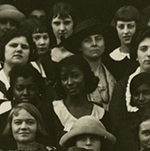 University Library
What She Said
University Library
What She Said
Part II: Women Together
Part III: Issue Spotlights
 University Library
What She Said
University Library
What She Said
Part II: Women Together
Part III: Issue Spotlights
Identifying the beginning of the women's rights movement in the United States is nearly impossible. It began in many places among different groups of women, including black women resisting slavery, women participating in the Lowell Mill strikes of the 1830s, women working in the abolitionist movement, women leading the Temperance movement, and more. While these social movements were distinct, many of them shared common links to democratic individualism and protestant values.
Often lacking experience and coordination, early women activists adopted different strategies, and achieved varied levels of success in fighting for rights. It was only in the years after the Civil War that a targeted fight for women's rights really got underway in the United States. Despite this delayed start, the preceding decades of activism awoke massive numbers of women to the power of political participation, and engendered widespread acceptance of women as a moral public voice in the nation.
The abolitionist and the temperance movements in particular engaged many women with politics, though members of the temperance movement initially perceived political protest as being fundamentally unladylike. Even so, many worked diligently to protect American families from the dangers of alcohol. Many women abolitionists went on to become prominent suffrage activists, including Lucretia Mott, Lucy Stone, and Julia Ward Howe. More than half the financial supporters of Sojourner Truth's autobiography were women, and the lists of presidents, chairs, and leaders of local abolitionist groups in newspapers like The American Freedman were overwhelmingly women.
Case 2, Early Suffrage Movement, is to your right on the east wall of the gallery.
1
Anna A. Gordon. Songs of the Young Woman's Christian Temperance Union. Chicago: The Woman's Temperance Publishing Association, 1889.M 2198 G66 S66 1889
2
Virgil W. Blanchard, M.D. The Duty of Woman in the Field of Temperance Reform: A Lecture. New York: Woman's American Temperance League, 1878.HV 5060 C67 1942
3
Eli F. Brown, M.D. Youth's Temperance Manual: An Elementary Physiology. New York: American Book Company, 1888.HV 5066 B76 1888
4
A. E. Grimke. Letters to Catherine E. Beecher in Reply to an Essay on Slavery and Abolitionism Addressed to A. E. Grimke. Boston: Isaac Knapp, 1838.E 449 B419
5
Narrative of Sojourner Truth: A Bondswoman of Olden Time… Boston: Sojourner Truth, 1875E 185.97 T88 1875
6
The American Freedman 1, no. 10 (January 1867). New York: The American Freedman's Union Commission.E 185.2 A5
